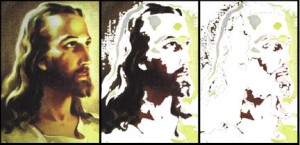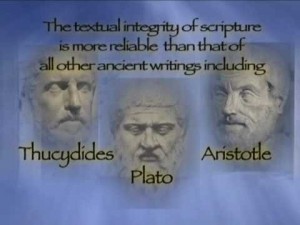I recently attended a dialogue between a Christian pastor and an Ahmadiyya Muslim imam. The topic of the dialogue was, Did Jesus Die on the Cross? (Please see my previous post, Did Jesus Die on the Cross, here) After the presentation by both of the speakers, no opportunity was given to the presenters to critique the presentation of the other presenter, and the moderator moved to open the floor to the audience for the Q & A segment.
I was impressed by the conviction and articulation of the members of the local churches when questioning the claims of the Imam, specifically his claim that Jesus didn’t die on the cross but was instead ‘swooned’ and then later traveled to India where he died a natural death. (Amongst Muslims, this is a belief that is particular to the Ahmadiyya movement, as all other Muslims reject the ‘theistic swoon theory’ and believe that Jesus was not crucified, and instead a substitute (either Simon of Cyrene, Judas, etc.) was crucified in His place and that Jesus was subsequently raised to Heaven by Allah.)
During the Q & A I posed a question to the Imam along the lines of, “Both the Bible and the Qur’an say that Jesus is a true prophet. Jesus stated/prophesied on numerous occasions in the Gospels that He would die and indicated the type of death He would die. How then can you claim that He didn’t die without saying that He is a liar and false prophet?”
 The Imam’s answer was amazing! Instead of addressing my question, he referred me (and the audience) to the book, The Five Gospels, stating that “it is your own Christian scholars who have proven that 80% of Jesus’ words in the New Testament are inauthentic and these statements by Jesus regarding His death are in that 80%. This is what your own scholars say so we really don’t know what Jesus said or didn’t say.” For those of you who are unfamiliar with this book, it is the ‘findings’ and ‘conclusions’ of the Jesus Seminar, a group of self-described scholars who meet twice a year to dissect biblical passages. Their goal: separate historical fact from mythology, which they do by voting via casting different colored beads into jars as to the authenticity of Jesus’ words as recorded in the New Testament gospel narratives. So far, they have rejected as myth the resurrection of Jesus from the dead, the virgin birth, all Gospel miracles, and a full 82% of the teachings normally attributed to Jesus–all dismissed as legendary accretions with no historical foundation. For example, only two words of the Lord’s Prayer survive as authentic: “Our Father.”[1] The Jesus Seminar are certainly not my scholars, nor can their methodology or findings be considered to be representative, or speak for, the majority of the New Testament scholarly community, regardless of what stripe they may be.
The Imam’s answer was amazing! Instead of addressing my question, he referred me (and the audience) to the book, The Five Gospels, stating that “it is your own Christian scholars who have proven that 80% of Jesus’ words in the New Testament are inauthentic and these statements by Jesus regarding His death are in that 80%. This is what your own scholars say so we really don’t know what Jesus said or didn’t say.” For those of you who are unfamiliar with this book, it is the ‘findings’ and ‘conclusions’ of the Jesus Seminar, a group of self-described scholars who meet twice a year to dissect biblical passages. Their goal: separate historical fact from mythology, which they do by voting via casting different colored beads into jars as to the authenticity of Jesus’ words as recorded in the New Testament gospel narratives. So far, they have rejected as myth the resurrection of Jesus from the dead, the virgin birth, all Gospel miracles, and a full 82% of the teachings normally attributed to Jesus–all dismissed as legendary accretions with no historical foundation. For example, only two words of the Lord’s Prayer survive as authentic: “Our Father.”[1] The Jesus Seminar are certainly not my scholars, nor can their methodology or findings be considered to be representative, or speak for, the majority of the New Testament scholarly community, regardless of what stripe they may be.
Considering that this is one of the resources that the Ahmadiyya movement is using as their authority on textual criticism, it should come as no surprise as to the unhistorical and confused position that they have taken as to Jesus’ death and resurrection. In presenting The Five Gospels as the ‘trump card’ in an attempt to neutralize and dismiss my point, the Imam unwittingly confirmed why he, and the Ahmadiyyan movement believe in a fictional story line regarding Jesus’ life, instead of the eyewitness, historically based life, death and resurrection of Jesus of Nazareth as presented in the New Testament Gospel narratives and extra-biblical sources.
Let’s begin with the presuppositions of the ‘little bead men’ of the Jesus Seminar which were laid out clearly in their very first meeting by the co-founder Robert Funk:
Even a casual perusal of the above statements will bring the reader to the following conclusion: from its inception the Jesus Seminar was put together with one purpose, and one purpose only, that of creating and/or fabricating a ‘new’ Jesus via a “new fiction, new story, new gospel, new plot.” The interesting connection with the Ahmadiyyan Muslims is that the founder of the movement, Mirza Ghulam Ahmad, followed the same path of extreme revisionism (bordering on fantasy) 100 years prior to the founding of the Jesus Seminar via his book, Jesus in India, in which he states that Jesus swooned on the cross, recovered, then traveled to India, died a ‘natural death’ and is buried in a tomb called Rauzabal in the state of Kashmir. Whatever these revisionist speculations and conjectures are, they are certainly not based on sound historical criteria and reliable sources, as F. F. Bruce so aptly states:
 In Jesus Under Fire , J.P. Moreland sums up what the Jesus Seminar is asking us to believe based on nothing more than the strength of their philosophic assumptions:
In Jesus Under Fire , J.P. Moreland sums up what the Jesus Seminar is asking us to believe based on nothing more than the strength of their philosophic assumptions:
William Lane Craig offers the following expose of the Jesus Seminar’s methodology and how they have attempted to create a ‘new gospel’ in their book, The Five Gospels:
Let me take just a couple of examples which are favorite sources of the Jesus Seminar. First, the so called Gospel of Thomas. The Jesus Seminar considers this such an important source that they include it along with Matthew, Mark, Luke, and John in their edition of The Five Gospels. Now what is the Gospel of Thomas? It is a writing which was discovered in Egypt just after World War II. It was part of a collection of Gnostic documents. Gnosticism was an ancient near eastern philosophy which held that the physical world is evil and the spiritual realm is good. Salvation comes through secret knowledge of the spiritual realm, which liberates the soul from its imprisonment in the physical world. The so called Gospel of Thomas is shot through with Gnostic philosophy. It was no doubt part of the literature of a Gnostic Christian cult, much like New Age cults in our own day. Greek fragments of the Gospel of Thomas as old as AD 200 have been found, and most scholars would date the original to have been written in the latter half of the second century after Christ. One evidence of this fact is that the Gospel of Thomas uses vocabulary that comes from second century translations and harmonies of the four gospels.Thus, the vast majority of scholars today regard the Gospel of Thomas as a derivative source from the second century after Christ which reflects the view of Christian gnosticism. Incredibly, however, fellows of the Jesus Seminar regard the Gospel of Thomas as an early, primary source concerning Jesus and use it to revise the portrait of Jesus found in the Gospels. Now what reasons do they have for dating the Gospel of Thomas so early? Amazingly, their whole approach to this question is reasoning in a circle. It goes like this:
1. The Gospel of Thomas is an early, primary source.“How do you know?”
2. Because no apocalyptic sayings are found in the Gospel of Thomas.“Why is that evidence of an early date?”
3. This is evidence of an early date because Jesus wasn’t into Apocalyptic.“How do you know he wasn’t?”
4. Because the Gospel of Thomas proves he wasn’t.“Why believe what the Gospel of Thomas says?”
(repeat) 1. The Gospel of Thomas is an early, primary source.
Thus, Howard Clark Kee of Boston University hails this procedure as “a triumph of circular reasoning!” British New Testament scholar Thomas Wright says it’s like Winnie the Pooh following his own tracks in the snow around a clump of trees and each time he sees more tracks he takes this as evidence that his quarry is even more numerous and more real than he thought before! No wonder that the fellows of the Jesus Seminar haven’t been able to convince very many of their colleagues by means of arguments like this![5]
New Testament scholar, Luke Timothy Johnson, gives the following expose on the real agenda of the Jesus Seminar:
N.T. Wright expounds on the complete lack of historical methodology of the Seminar:
 The almost unanimous position of the scholarly community, whether liberal, agnostic, conservative or otherwise, is that:
The almost unanimous position of the scholarly community, whether liberal, agnostic, conservative or otherwise, is that:
FACT #2: On the Sunday following the crucifixion, Jesus’ tomb was found empty by a group of his women followers.
FACT #3: On multiple occasions and under various circumstances, different individuals and groups of people experienced appearances of Jesus alive from the dead.
FACT #4: The original disciples believed that Jesus was risen from the dead despite their having every predisposition to the contrary-His resurrection was the very origin of the disciples belief and vindication of Jesus’ claims to Deity.
The Resurrection Hypothesis passes all of the standard criteria for being the best explanation, such as explanatory power, explanatory scope, plausibility, and so forth.
I will end with a statement built on historical criteria and sound methodology regarding the life, death and Resurrection of Jesus of Nazareth:
References:
[1] Greg Koukl, Jesus Seminar Under Fire, here
[2] Robert Funk, opening remarks of launch of Jesus Seminar in March 1985 in Berkeley, California
[3] F. F. Bruce, The New Testament Documents-Are they reliable?, Eerdmans, 2003, p. 123
[4] J. P. Moreland and Wilkins, Jesus Under Fire, Grand Rapids: Zondervan, 1995, p. 22
[5] William Lane Craig, Rediscovering the Historical Jesus: The Presuppositions and Pressumptions of the Jesus Seminar, Faith and Mission 15 (1998), pg. 3-15
[6] Luke Timothy Johnson, The Real Jesus (San Francisco: Harper San Francisco, 1996), p. 6
[7] N. T. Wright, Five Gospels but No Gospel: Jesus and the the Seminary, originally published in Authenticating the Activities of Jesus, ed. Bruce Chilton and Craig A. Evans, Leiden: Brill, 1999, 83–120
[8] William Lane Craig, Rediscovering the Historical Jesus: The Presuppositions and Pressumptions of the Jesus Seminar, Faith and Mission 15 (1998), pg. 3-15
How Seriously Do Scholars Take The Jesus Seminar?-Dr. William Lane Craig
What About the Jesus Seminar-Dr. Gary Habermas
What is the Jesus Seminar?-Craig Evans, N.T. Wright, and more
